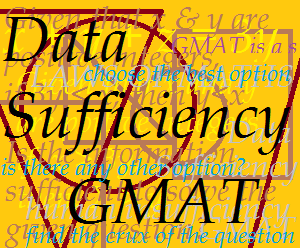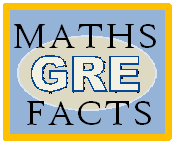Solution to Question in ‘Tackle Options in GMAT DS Questions the Oak’s Academy Way’ Blog Post
Question:
Given that a, b, c, d, e are positive integers and that ‘b’ is an odd integer, is the product (a+b)(a+c)(a+d)(a+e) an odd integer?
(1) a is an odd integer
(2) c is an even integer
Answer: (D)
Solution:
In order to solve this question, we first need to review a few basic addition and multiplication rules:
|
Addition Rules |
Multiplication Rules |
||
|
When Added |
Sum |
When Multiplied |
Product |
|
1. odd + odd = |
even |
4. odd × odd = |
odd |
|
2. odd + even = |
odd |
5. odd × even = |
even |
|
3. even + even = |
even |
6. even × even = |
even |
Working with Statement (1)
Now according to the method we first take statement (1).
Statement (1) says, ‘a’ is odd and we already know that b is odd (the default information given in the question statement). Since odd + odd = even, the first bracket has to be even. Thus, the first bracket in the multiplication becomes even, and as soon as one number in a multiplication sum becomes even, the product HAS TO BE even (rules 5 and 6)!
Hence, statement (1) is sufficient to solve the question, so the answer has to be either (A) ‘Statement (1) alone is sufficient but statement (2) alone is not sufficient to answer the question asked’ or (D) ‘Each statement alone is sufficient to answer the question asked’’.
Working with Statement (2)
In order to decide whether the answer is (A) or (D), we go to the next step in the method: working with statement (2).
Statement (2) tells us that ‘c’ is even. We already know that ‘b is odd’ (the default information given in the question statement). But we have no information about whether ‘a’ is odd or even, so we have to consider both cases.
- Now, if ‘a’ is odd, the first bracket becomes even (since ‘b’ is odd, and odd + odd is even) and thus, the answer will also be EVEN.
- If ‘a’ is even, the first bracket becomes odd (since odd + even = odd). HOWEVER, there is one more thing we must note. Since ‘a’ and ‘c’ are even, the second bracket is even. Now, if even one number is even, the entire product has to be even (rule).
Thus, though information given in statement (2) apparently looks ambiguous and irrelevant, it is actually sufficient to reach a final answer!
Therefore, the answer is option (D)!
by our Quantitative Reasoning Faculty
In last time’s blog we looked at why DS is so important in GMAT. In this one we’ll take a look at the 3 key things that you need to do in order to tackle this unfamiliar question type. There are:
1. Learn the Options
The first step in learning DS is to get absolutely familiar with the options. Fortunately, in DS, this is easy because the five options are always as follows:

(A) Statement (1) alone is sufficient but statement (2) alone is not sufficient to answer the question asked
(B) Statement (2) alone is sufficient but statement (1) alone is not sufficient to answer the question asked
(C) Both statements (1) and (2) together are sufficient to answer the question asked, but neither statement alone is sufficient
(D) Each statement alone is sufficient to answer the question asked
(E) Statements (1) and (2) together are not sufficient to answer the question asked and additional data are needed.
2. Remember the Aim
Remember, in DS our aim is NOT TO FIND THE FINAL ANSWER to the question but just to verify whether the INFORMATION GIVEN IN THE TWO STATEMENTS IS SUFFICIENT TO REACH TO THE FINAL ANSWER!
So while solving the question if, at any intermediate step, you realize that you can reach the final answer then QUIT and mark the option accordingly.
3. Understand the Approach
Now let’s have a look at how you should approach DS questions.
Step 1: Carefully Read the Question Statement and Find the Crux of the Question
After closely examining the question statement and before you read the information given in statements (1) and (2), ‘identify the crux of the question’. What I mean by ‘the crux of the question’ is the piece of information that is the key to the solution. Sometimes you have to think a little bit before you get it. But once you have it, it will lead you straight to the answer. For example, have a look at this question statement:
If x and y are distinct positive integers then:
(1) x = 2 (y + 3)
(2) x2 = y2 + 4
Now, if you have lost touch with maths, just the sight of that forest of terms is enough to want to make you give up. But again, remember that we are not at all interested in solving this inequality. We just need find out whether the expression on the left hand side is positive or not (that’s what is implied by >0) – and this is a much simpler matter! Further, in this mass of algebraic symbols is a key that reveals itself when you examine about the expression and think about it a little.
In order to get this key, the first thing to do is to carefully observe the question statement. First and foremost, it says, that x and y are distinct positive integers. This is a very important piece of information – and you’ll understand why in a moment. Secondly, if you observe the numerator of the expression on the left, it consists of additions throughout. Given both these pieces of information, the numerator has to be positive in nature: it is the sum of distinct positive integers (which is why the information about x and y was important). By the same logic, even the second bracket in the denominator has to be positive. The only unknown factor, therefore, is the first bracket in the denominator, i.e., (x – y) and this is what holds the key to the entire problem.
The entire expression will be positive if and only if (x – y) > 0, in short, if x > y. On the other hand, if x < y, the whole expression will be negative. So, the whole gigantic problem is reduced to an extremely simple question: is x > y? Once we have arrived at this conclusion, cracking the rest of the problem is really easy: any information about the relative magnitudes of x and y will be sufficient to arrive at the answer! Thus, in this case, the crux of the question (the key to the solution) is realizing that all we need to find out in order to answer this question is whether statements (1) and (2) allow us to decide whether x is bigger than y or vice versa.
Once you have reached this stage you are can confidently take on the options of this seemingly insoluble problem. The discussion above takes care of Step 1 of the approach i.e. carefully reading the question statement and finding the crux of the question. In the next post we’ll look at Step 2 of the approach: tackling the options in DS questions – and we’ll be giving you tips that will reduce the complexities to a few simple steps! Watch for the tips in our third DS blog post next week.
 Many students are interested in joining American universities in January, that is, in the spring semester. But, there is a common misunderstanding that many universities do not accept students in the spring semester and that funding opportunities are also fewer. This, however, is not true. Almost 95% of American universities admit students for the spring semester.
Many students are interested in joining American universities in January, that is, in the spring semester. But, there is a common misunderstanding that many universities do not accept students in the spring semester and that funding opportunities are also fewer. This, however, is not true. Almost 95% of American universities admit students for the spring semester.
Opportunities for financial assistance in spring are also as good as in fall. Of course, in some universities, a few courses are offered only in the fall semester, so students who join in spring cannot take them. However, with regard to financial aid, most universities offer Research and Teaching Assistantships, tuition waivers etc. only to students who have completed one semester, with a very good GPA (Grade Point Average). Hence, whether you join in the fall or spring semester does not really make a difference.
 The best time to apply for the spring semester is around June or July of the previous year, which is fast approaching. Of course, many universities accept applications in August and even in September, but if you want admission to a good university, it is better to apply before July of the previous year. Submitting your application early will also help you to get your I-20 early and thus you will be able to apply for a visa by October or November, or at least in early December.
The best time to apply for the spring semester is around June or July of the previous year, which is fast approaching. Of course, many universities accept applications in August and even in September, but if you want admission to a good university, it is better to apply before July of the previous year. Submitting your application early will also help you to get your I-20 early and thus you will be able to apply for a visa by October or November, or at least in early December.
We strongly recommend that you write the GRE and TOEFL before the 15th July so that it will be possible for you to submit all your online applications and courier the necessary documents before 25th July.
Therefore start preparing for GRE and TOEFL now and book your test date at the earliest. Simultaneously, start preparing documents like your Statement of Purpose (SOP), transcripts, and recommendation letters. Check the websites of different universities and list the names of universities where your specialization is available.
There are good opportunities in spring. Make sure that you don’t miss them! If you are not too sure of whether you should apply for the spring semester or not read our post titled “Should I Apply for the Spring Semester (January)?”
Also, look out for our post: “Applying for Spring (Jan) 2014 – A Step-By-Step Explanation”
Now, here’s a tip about the weird GRE question type called Quantitative Comparison or simply QC. As we know, in QC questions there are two columns, ‘A’ and ‘B’, containing some quantities. Our job is to evaluate the quantities and compare their magnitudes. In QC questions, the options are always as follows:
(A) Quantity under Column A is GREATER THAN quantity under Column B
(B) Quantity under Column A is LESS THAN quantity under Column B
(C) Quantity under Column A is EQUAL TO quantity under Column B
(D) RELATIONSHIP CANNOT BE ESTABLISHED using the given information.
Now look at this example:
x2 – 2x – 24 = 0
y2 – 3y + 2 = 0
Column A Column B
x y
The question asks us to compare ‘x’ and ‘y’. In order to get the answer, we need to solve both the quadratic equations. When we do this, we get the following values: x (4, -6) and y (2, 1)
Thus, if we pick 4 as the value of ‘x’, it is greater than both values of ‘y’. Hence, option (B) and option (C) can be rejected outright.
Now, we are left with only two options, (A) and (D). But if we pick -6 as the value of ‘x’, it is less than both the values of ‘y’ so, we have to eliminate option (A) and thus, we have option (D) as the final answer!
Why was this example given? To show you that is that the only time we need to be extra cautious when solving QC questions is when we think that the answer is probably option D!
Now, try this one:
X < (1/X)
Column A Column B
X X2
see answer here


